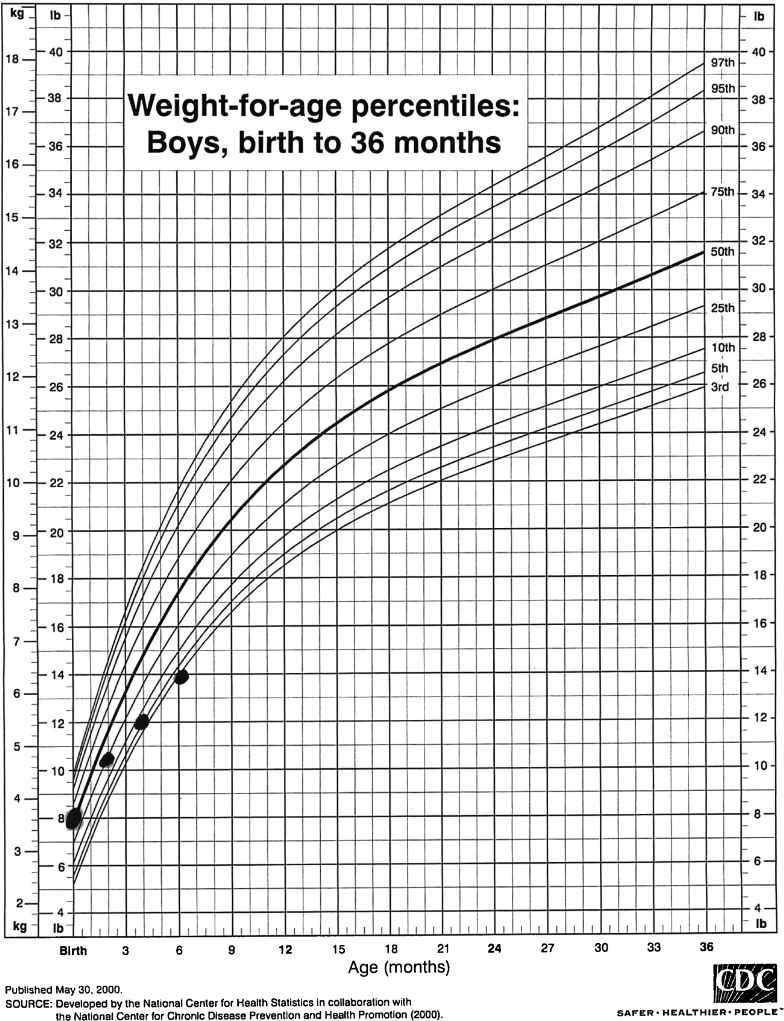(Courtesy of Susan John, MD.)
a. Multiple sclerosis
b. Acute disseminated encephalomyelitis (ADEM)
c. Malignant astrocytoma
d. Bacterial meningitis
e. Neurocysticercosis
309. The examination of a child’s back is shown below. Which of the following statements about this child’s condition is true?
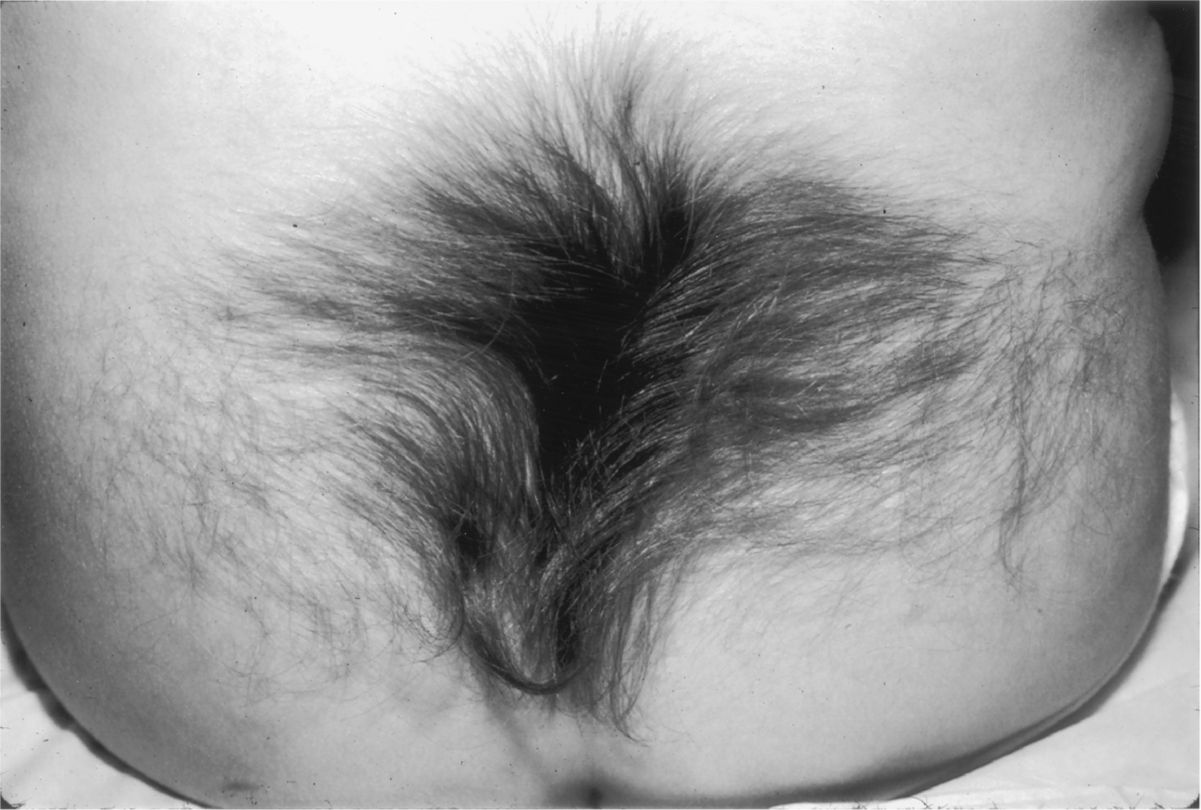
(Courtesy of Adelaide Hebert, MD.)
a. Symptoms are more likely to be seen in younger children and resolve as the child grows older.
b. Pes planus (flat foot) is commonly seen in adolescents with this condition.
c. Hypertrophy of the lower extremity muscles on one or both sides is associated with a better prognosis.
d. Hyperreflexia of the lower extremities is diagnostic at all ages.
e. Frequent urinary tract infections are commonly found.
310. A 6-month-old child was at the 50th percentile at birth for length, weight, and head circumference. His growth curve from his last visit 1 week ago is shown. On his developmental assessment, you noted that he rolled from stomach to back occasionally but not very well from back to stomach. He could bear weight on his legs but would not sit without assistance. Today, the family calls you urgently at 7:00 AM noting that their child seems unable to move the right side of his body. Which of the following conditions might explain this child’s condition?
a. Phenylketonuria
b. Homocystinuria
c. Cystathioninuria
d. Maple syrup urine disease
e. Histidinemia
CDC Growth Charts: United States
311. On a newborn boy’s first examination, you note a prominent occiput, a broad forehead, and an absent anterior fontanelle The infant’s head is long and narrow as shown in the photograph. The remainder of the physical examination, including a careful neurological evaluation, is normal. You note that the baby was born via cesarean section for cephalopelvic disproportion. When you enter the mother’s room, the first question she asks is about her baby’s head shape. Which of the following is the most appropriate statement to the mother about this infant’s condition?
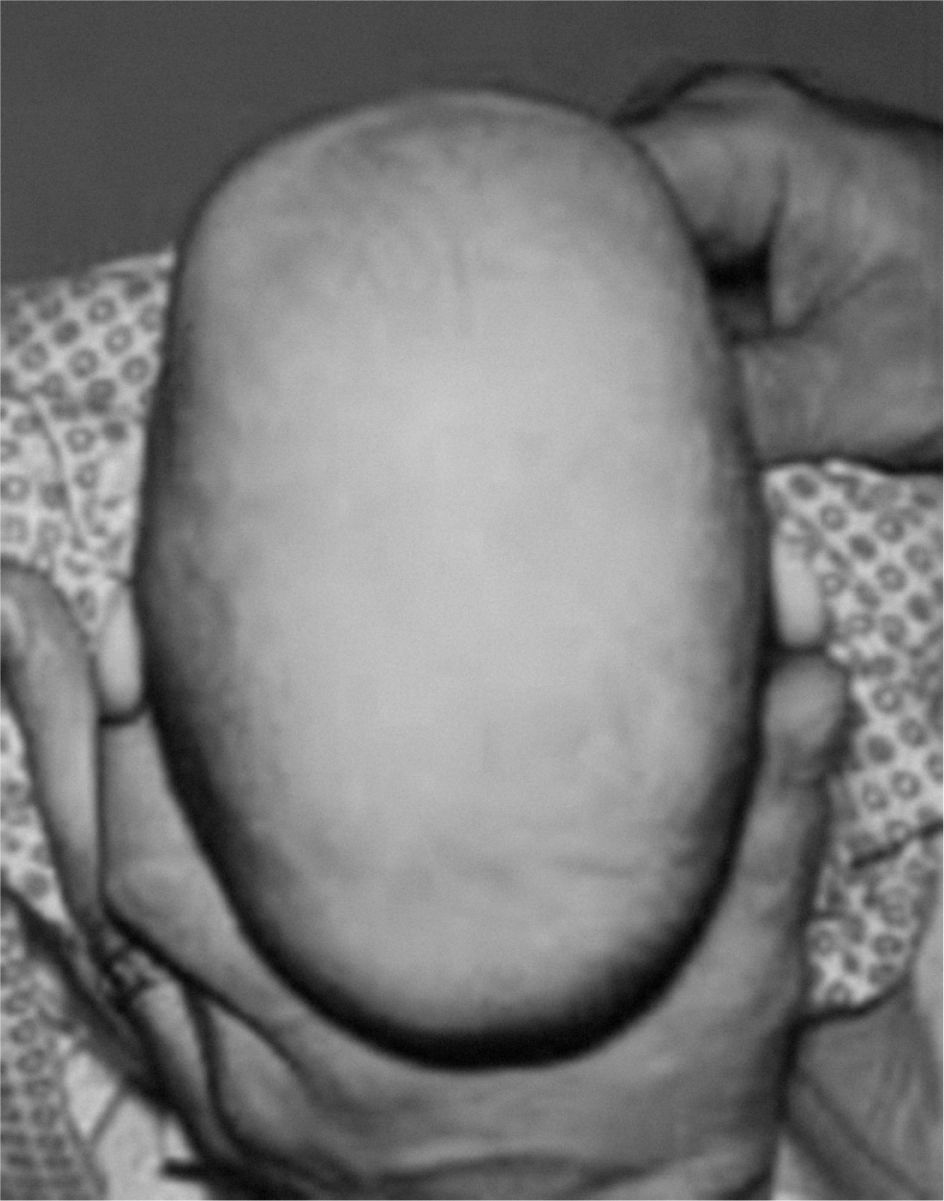
(Courtesy of David I. Sandberg, MD.)
a. The condition is usually associated with other genetic defects.
b. The condition is usually associated with hydrocephalus.
c. Patients with this condition usually develop seizures.
d. The condition is associated with pituitary abnormalities.
e. The condition requires referral to a surgeon.
312. A 4-year-old child is observed to hold his eyelids open with his fingers and to close one eye periodically, especially in the evening. He has some trouble swallowing his food. He usually appears sad, although he laughs often enough. He can throw a ball, and he runs well. Which of the following is most likely to aid in the diagnosis?
a. Muscle biopsy
b. Creatine phosphokinase (CPK)
c. Effect of a test dose of edrophonium
d. Chest x-ray
e. Antinuclear antibodies (ANAs)
313. A 14-year-old girl with a history of seizures is admitted to the hospital with the diagnosis of status epilepticus. Her valproic acid level is in the therapeutic range. You arrange a 24-hour video electroencephalogram (EEG). During the EEG, she has several episodes of tonic and clonic movements with moaning and crying, with no loss of bowel or bladder control. The neurologist tells you that during the events the EEG had excessive muscle artifact but no epileptiform discharges. Which of the following treatments is the most appropriate for this condition?
a. Add a scheduled benzodiazepine for her muscular symptoms.
b. Add carbamazepine to her current seizure medication.
c. Increase her dose of valproic acid.
d. Withdraw all seizure medications.
e. Request a psychiatric evaluation.
314. A previously healthy 7-year-old child suddenly complains of a headache and falls to the floor. When examined in the emergency room (ER), he is lethargic and has a left central facial weakness and left hemiparesis with conjugate ocular deviation to the right. Which of the following is the most likely diagnosis?
a. Hemiplegic migraine
b. Supratentorial tumor
c. Todd paralysis
d. Acute subdural hematoma
e. Acute infantile hemiplegia
315. A 5-month-old child was normal at birth, but the family reports that the child does not seem to look at them any longer. They also report the child seems to “startle” more easily than he had before. Testing of his white blood cells (WBCs) identifies the absence of β-hexosaminidase A activity, confirming the diagnosis of which of the following?
a. Niemann-Pick disease, type A
b. Infantile Gaucher disease
c. Tay-Sachs disease
d. Krabbe disease
e. Fabry disease
316. The family of a 4-year-old boy has just moved into your area. The child was recently brought to the emergency department (ED) for an evaluation of abdominal pain. Although appendicitis was ruled out in the ED and the child’s abdominal pain has resolved, the ED physician requested that the family follow up in your office to evaluate an incidental finding of an elevated creatine kinase. The family notes that he was a late walker (began walking independently at about 18 months of age), that he is more clumsy than their daughter was at the same age (especially when trying to hold onto small objects), and that he seems to be somewhat sluggish when he runs, climbs stairs, rises from the ground after he sits, and rides his tricycle. A thorough history and physical examination are likely to reveal which of the following?
a. Hirsutism
b. Past seizure activity
c. Proximal muscle atrophy
d. Cataracts
e. Enlarged gonads
317. A 9-year-old girl is brought by her sister to her pediatrician with the complaint of severe, intermittent headaches for the past several months, one of which resulted in her going to the ER. The physical examination today, including a careful neurologic examination, is normal. The headache is diffuse, throbbing, lasts several hours, and is not associated with vomiting or other symptoms. The child cannot feel the headaches coming on; they appear on all days of the week; and usually the headaches are gone when she awakens from a nap. The child reports that she is doing well in school, plays clarinet in the school band, loves to play with her Chihuahua, and has “lots of friends.” The sister is not sure, but she thinks their father, who lives in another state, may have headaches. Which of the following is the most appropriate next step in the diagnosis and management of this child’s likely condition?
a. Initiation of ibuprofen immediately at the onset of symptoms
b. Trial of oral antihistamine and nasal steroids
c. MRI of the brain
d. Computed tomographic (CT) scan of the sinuses and initiation of oral antibiotics
e. Lumbar puncture for cell count and protein levels
318. Examination of the cerebrospinal fluid (CSF) of an 8-year-old, mildly febrile child with nuchal rigidity and intermittent stupor shows the following: WBCs 85/μL (all lymphocytes), negative Gram stain, protein 150 mg/dL, and glucose 15 mg/dL. A CT scan with contrast shows enhancement of the basal cisterns by the contrast material. Which of the following therapies is likely to be most beneficial for this child’s condition?
a. Initiation of rapamycin (mTOR inhibitors) therapy
b. Administration of isoniazid, rifampin, pyrazinamide, and streptomycin or ethambutol
c. Intravenous heparin and subcutaneous enoxaparin (Lovenox)
d. Intravenous ceftriaxone and vancomycin
e. Administration of acetazolamide (Diamox)
319. An irritable 6-year-old child has a somewhat unsteady but nonspecific gait. Physical examination reveals a very mild left facial weakness, brisk stretch reflexes in all four extremities, bilateral extensor plantar responses (Babinski reflex), and mild hypertonicity of the left upper and lower extremities; there is no muscular weakness. Which of the following is the most likely diagnosis?
a. Pontine glioma
b. Cerebellar astrocytoma
c. Tumor of the right cerebral hemisphere
d. Subacute sclerosing panencephalitis (SSPE)
e. Progressive multifocal leukoencephalopathy
320. A 2-year-old boy has been doing well despite his diagnosis of tetralogy of Fallot. He presented to an outside ER a few days ago with a complaint of an acute febrile illness for which he was started on a “pink, bubble-gum tasting antibiotic.” His mother reports that for the past 12 hours or so he has been holding his head saying it hurts and he is less active than normal. On your examination, he seems to have a severe headache, nystagmus, and ataxia. Which of the following would be the most appropriate first test to order?
a. Urine drug screen
b. Blood culture
c. Lumbar puncture
d. CT or MRI of the brain
e. Stat echocardiogram
321. A 6-year-old child is hospitalized for observation because of a short period of unconsciousness after a fall from a playground swing. He has developed unilateral pupillary dilatation, focal seizures, recurrence of depressed consciousness, and hemiplegia. Which of the following is the most appropriate management at this time?
a. Spinal tap
b. CT scan
c. Rapid fluid hydration
d. Naloxone
e. Gastric decontamination with charcoal
322. A 6-year-old boy is seen in the office for evaluation of polyuria. Further questioning reveals several months of headache with occasional emesis. Your physical examination reveals a child who is less than 5% for weight. He has mild papilledema. His glucose is normal, and his first urine void specific gravity after a night without liquids is 1.005 g/mL. Which of the following might also be seen in this patient?
a. Sixth nerve palsy
b. Unilateral cerebellar ataxia
c. Unilateral pupillary dilatation
d. Unilateral anosmia
e. Bitemporal hemianopsia
323. A 6-year-old boy had been in his normal state of good health until a few hours prior to presentation to the emergency department. His mother reports that he began to have difficulty walking, and she noticed that he was falling and unable to maintain his balance. Which of the following is the most likely to allow diagnosis of his condition?
a. Obtain urine drug screen.
b. MRI to evaluate his corpus callosum.
c. Close scrutiny of his skin for telangiectasia.
d. Perform a muscle biopsy of the gastrocnemius muscle.
e. Identification of a triplet repeat expansion on chromosome 9.
324. A 9-year-old child has developed headaches that are more frequent in the morning and are followed by vomiting. Over the previous few months, his family has noted a change in his behavior (generally more irritable than usual) and his school performance has begun to drop. Imaging of this child is most likely to reveal a finding in which of the following regions?
a. Subtentorial
b. Supratentorial
c. Intraventricular
d. Spinal canal
e. Peripheral nervous system
325. A previously healthy 3-week-old boy was seen in your office 5 days ago. This is the family’s third child, was the product of an uneventful pregnancy, and they have no concerns other than feeling that he does not now stool so often as their other breast-fed children. Your examination is normal. Over the next several days, he has worsening of his “constipation” (despite the family’s trying a number of home remedies recommended by the grandmother), he is increasingly lethargic, he has developed a weak cry, and he seems to have decreased spontaneous movement. Overall, the family reports that his eating has decreased and he seems to be gagging when he eats. You admit him to the hospital for a “rule out sepsis” evaluation. You find on your examination a poor gag and suck reflex with drooling from his mouth, diminished corneal reflexes, ptosis, and loss of head control. His lumbar puncture attempt must be aborted after the collection of the first tube of fluid is gathered due to his developing respiratory distress while curled for the procedure. Which of the following is likely to confirm your suspicions about his diagnosis?
a. Spinal fluid HSV culture results
b. Examination of both parents for electromyographic depiction of myotonic discharges
c. Resolution of his hypotonia upon administration of edrophonium
d. Finding of a tick buried in the hair on his scalp
e. Identification of botulinum toxin in the infant’s serum
326. At birth, an infant is noted to have an abnormal neurologic examination. Over the next few weeks, he develops severe progressive central nervous system (CNS) degeneration, an enlarged liver and spleen, macro-glossia, coarse facial features, and a cherry-red spot in the eye. Which of the following laboratory findings most likely explains this child’s problem?
a. Reduced serum hexosaminidase A activity
b. Deficient activity of acid β-galactosidase
c. Defective gene on the X chromosome
d. Complete lack of acid β-galactosidase activity
e. Deficient activity of galactosyl-3-sulfate-ceramide sulfatase (cerebroside sulfatase)
327. The parents of a 2-year-old girl bring her to the emergency center after she had a seizure. Although the parents report she was in a good state of health, the vital signs in the emergency center reveal a temperature of 39°C (102.2°F). She is now running around the room. Which part of the story would suggest the best outcome in this condition?
a. A CSF white count of 100/μL.
b. Otitis media on examination.
c. The seizure lasted 30 minutes.
d. The child was born prematurely with an intraventricular hemorrhage.
e. The family reports the child to have had right-sided tonic-clonic activity only.
328. About 12 days after a mild upper respiratory infection, a 12-year-old boy complains of weakness in his lower extremities. Over several days, the weakness progresses to include his trunk. On physical examination, he has the weakness described and no lower extremity deep tendon reflexes, muscle atrophy, or pain. Spinal fluid studies are notable for elevated protein only. Which of the following is the most likely diagnosis in this patient?
a. Bell palsy
b. Muscular dystrophy
c. Guillain-Barré syndrome
d. Charcot-Marie-Tooth disease
e. Werdnig-Hoffmann disease
329. The developmentally delayed 6-month-old child in the picture below had intrauterine growth retardation (including microcephaly), hepato-splenomegaly, prolonged neonatal jaundice, and purpura at birth. The calcific densities in the skull x-ray shown are likely the result of which of the following?
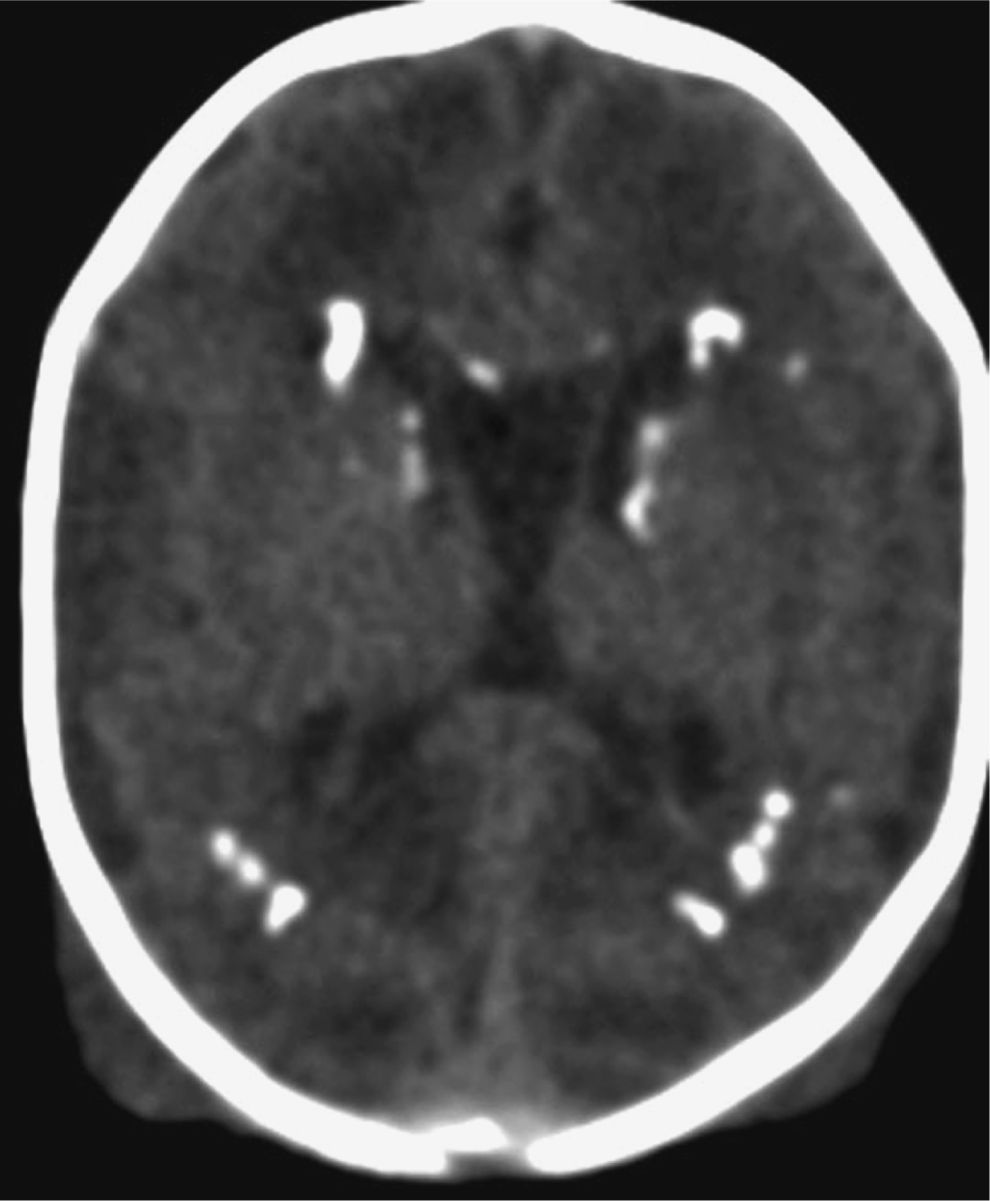
(Courtesy of Susan John, MD.)
a. Congenital cytomegalovirus (CMV) infection
b. Congenital toxoplasmosis infection
c. Congenital syphilis infection
d. Tuberculous meningitis
e. Craniopharyngioma
330. The infant pictured below develops infantile spasms. Which of the following disorders is most likely to be affecting this infant?
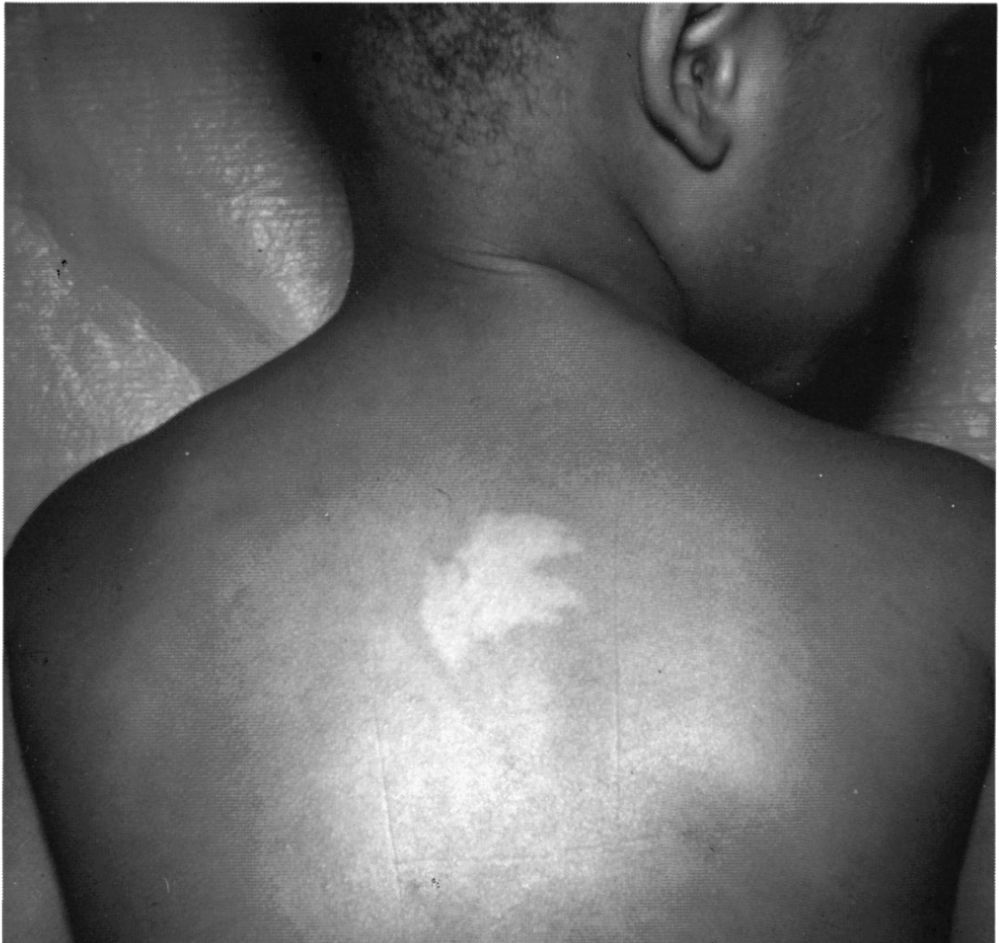
a. Neurofibromatosis
b. Tuberous sclerosis
c. Incontinentia pigmenti
d. Pityriasis rosea
e. Psoriasis
331. A newborn infant has respiratory distress and trouble feeding in the nursery. The mother has no significant medical history, but the pregnancy was complicated by decreased fetal movement. On physical examination, you note that aside from shallow respirations and some twitching of the fingers and toes, the infant is not moving, and is very hypotonic. In the mouth, there is pooled saliva and you note tongue fasciculations. Deep tendon reflexes are absent. Spinal fluid is normal. Appropriate statements about this condition include which of the following statements?
a. The condition is caused by the absence of the muscle cytoskeletal protein dystrophin.
b. The condition is caused by the degeneration of anterior horn cells in the spinal cord.
c. The condition is caused by the antibodies that bind the acetylcholine receptor at the postsynaptic muscle membrane.
d. The condition is caused by progressive autoimmune demyelination.
e. The condition is caused by birth trauma.
332. A 3-year-old boy’s parents complain that their child has difficulty walking. The child rolled, sat, and first stood at essentially normal ages and first walked at 13 months of age. Over the past several months, however, the family has noticed an increased inward curvature of the lower spine as he walks and that his gait has become more “waddling” in nature. On examination, you confirm these findings and also notice that he has enlargement of his calves. Which of the following is the most likely diagnosis?
a. Occult spina bifida
b. Muscular dystrophy
c. Brain tumor
d. Guillain-Barré syndrome
e. Botulism
333. Your 6-year-old son awakens at 1:00 AM screaming. You note that he is hyperventilating, is tachycardic, and has dilated pupils. He cannot be consoled, does not respond, and is unaware of his environment. After a few minutes, he returns to normal sleep. He recalls nothing the following morning. Which of the following is the most appropriate next step in his management?
a. Obtain an EEG
b. Observation only
c. Urine toxicology screen
d. Psychiatric evaluation
e. Trial of ergotamine containing nonsteroidal anti-inflammatory medications
334. A previously healthy 16-year-old girl presents to the emergency center with the complaint of “falling out.” She was with her friends at a local fast food restaurant when she felt faint and, according to her friends, lost consciousness for about a minute. There was no seizure activity noted, but the friends did notice her arms twitching irregularly. She is now acting normally. She denies chest pain or palpitations, and her electrocardiogram (ECG) is normal. Further management of this patient should include which of the following?
a. Obtain an EEG.
b. Refer to a child psychiatrist.
c. Begin β-blocker therapy
d. Encourage adequate fluid and salt intake.
e. Obtain serum and urine drug screens.
Questions 335 to 337
Headache in children can often be a concerning symptom to parents, but usually can be explained with a careful history and physical examination. Choose the headache associated with the clinical presentation listed below. Each lettered option may be used once, more than once, or not at all.
a. Tension headache
b. Factitious headache
c. Vascular headache (migraine)
d. Increased intracranial pressure
e. Hemiplegic migraine
335. A 15-year-old girl has an acute, recurrent, pulsatile headache localized behind the eyes that tends to occur more frequently around menses. She has no symptoms that occur prior to the headache; her neurologic examination is normal.
336. A 7-year-old boy has chronic, worsening headache without preceding symptoms. He complains of emesis in the morning before breakfast for the last 2 weeks.
337. A 12-year-old boy has chronic headache that worsens during the school day. These headaches are not associated with nausea or emesis, and he does not have any symptoms prior to the headache.
Questions 338 to 340
For each description, select the most likely diagnosis. Each lettered option may be used once, more than once, or not at all.
a. Transient tic disorder of childhood
b. Tourette syndrome
c. Sydenham chorea
d. Dystonia
e. Cerebral palsy
338. Eye blinking or throat-clearing noises in an otherwise healthy 8-year-old boy.
339. A 6-year-old boy with emotional lability, poor school performance, and milkmaid’s grip (irregular contractions of the hand muscles when squeezing the examiner’s fingers).
340. An 8-year-old hospitalized boy with unusual “spasms” of his neck and arms shortly after receiving Phenergan for nausea caused by his chemotherapy.
Questions 341 to 343
For each diagnosis listed, select the most common clinical sign or symptom. Each lettered option may be used once, more than once, or not at all.
a. A 6-month-old child with blindness on the same side as a large facial lesion
b. An infant with infantile spasms, a hypsarrhythmic EEG pattern, and ash-leaf depigmentation on her back
c. An 18-year-old patient with a history of fractures and optic gliomas, who now has developed a malignant schwannoma
d. A 2-year-old child with multiple episodes of skin infection and failure to thrive
e. A 14-year-old girl with a history of precocious puberty who now develops a large goiter
341. Neurofibromatosis Type I
342. PHACE syndrome
343. Tuberous sclerosis
Stay updated, free articles. Join our Telegram channel

Full access? Get Clinical Tree


